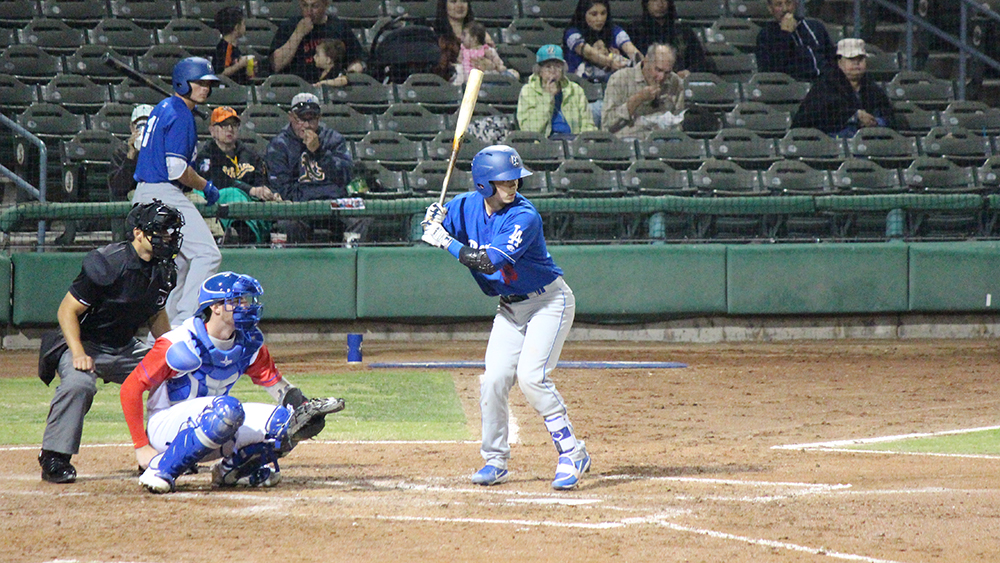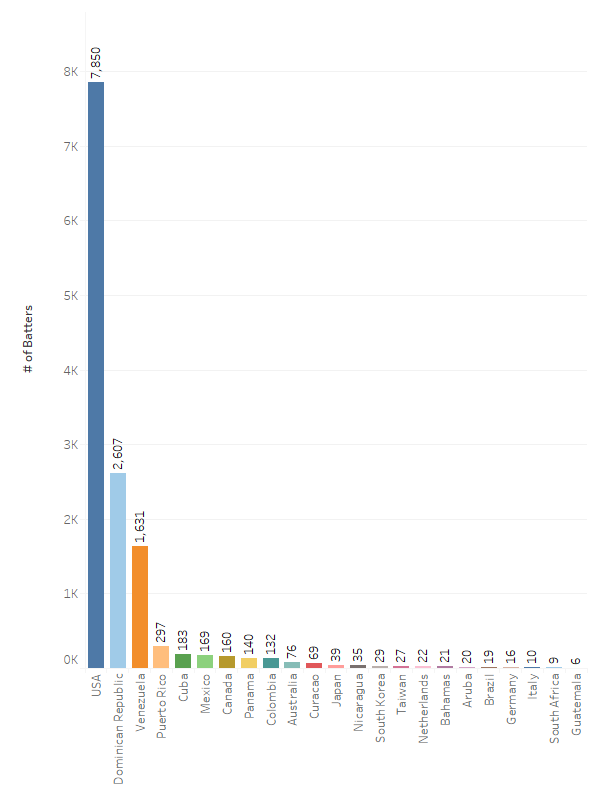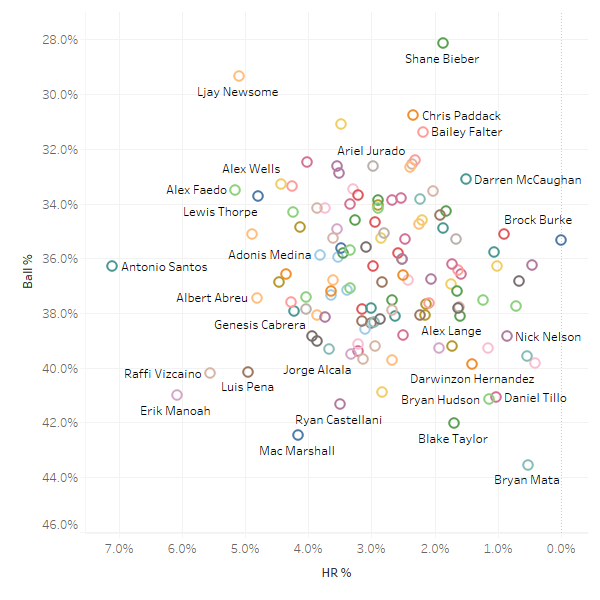Let’s Find Some 2019 Sleeper Prospects

Rylan Bannon isn’t the toolsiest prospect, but his skill set has been seen in sleeper prospects before. (via Dustin Nosler)
What is a “sleeper” prospect?
To me, the term sleeper implies a certain level of obscurity, sufficient that the vast majority of baseball fans would not have heard of him. For example, Cavan Biggio, is technically not a top 100 prospect, but he shows up on fantasy lists and is generally well known as a probable major league asset of some value. My goal today is to shed some light on 10 prospects who aren’t getting much love, but show interesting potential.
Perhaps a more accurate definition would be an implicit level of under-valuation. In other words, assets who aren’t properly priced by the baseball market. I wrote a couple of “sleeper prospect” articles that I encourage you to read. In the first one, I looked at Fly Ball Distance, highlighting Carlos Rincon and Lane Thomas. In the second, I looked at Pitch Framing, highlighting Sicnarf Loopstok. These three remain as my top three sleeper prospects for 2019. Let’s dig in a bit deeper.
Sleeper Prospect No. 1 – Lane Thomas 40FV (Profile)
McDongenhagen, a FanGraphs audio project, described Thomas as having meaningful raw power and a good defensive outfielder, which is important when assessing the chances a player will get consistent playing time in the majors. He’s played most of his minor league career as a center fielder, supporting the theory that he’s likely to be at least average defensively. He’s currently blocked by some impressive Cardinals depth in the outfield, but so were Cody Bellinger with the Dodgers, and Joc Pederson before him. Eventually, talent plays, and, Lane Thomas is good. Really good.
Let’s cherry-pick some top prospects and see how Thomas stacks up against them:
| Batter Name | Age – Batter | FB Dist + | HR | Swing & Miss % | SwStr% | wOBAContact |
|---|---|---|---|---|---|---|
| Eloy Jimenez | 21.6 | 108 | 22 | 25.1% | 12.7% | 0.457 |
| Keston Hiura | 22.0 | 100 | 6 | 22.7% | 11.1% | 0.367 |
| Kyle Tucker | 21.4 | 105 | 24 | 25.9% | 12.6% | 0.479 |
| Lane Thomas | 22.8 | 108 | 27 | 21.1% | 8.8% | 0.423 |
| Nathaniel Lowe | 23.0 | 106 | 17 | 19.3% | 8.5% | 0.456 |
| Nick Senzel | 22.9 | 103 | 6 | 23.3% | 10.4% | 0.443 |
| Yordan Alvarez | 21.0 | 107 | 22 | 22.2% | 9.3% | 0.488 |
Numbers above are for 2018 at Double-A or Triple-A. Not only did Lane Thomas hit more home runs than any of these guys, he backed it up with strong fly ball distance and solid wOBA on Contact. More impressively, he did this with a very solid 21.1 whiff rate and a minuscule 8.8 percent SwStr% (Swinging Strike rate). A center fielder, with power, who gets to that power without swing and miss problems? That’s a legit top 100 prospect in my books. This was Thomas’ first full season in the Cardinals organization, which may have something to do with his surge. I’m all in on Thomas.
Sleeper Prospect No. 2 – Carlos Rincon 40/40+ FV (Profile)
Rincon led all hitters in High-A last season (minimum 100 plate appearances) in wRC+ with a spectacular 220, backed up by some very strong (Joey Gallo strong) fly ball distances. If he were a “pedigree” type prospect, he would be all over top 100 lists, especially with back-to-back 20 homer seasons. Alas, he was a little known $350K signing by he Dodgers out of the Dominican Republic. The weird thing about Rincon is that he wasn’t nearly as good in 2017, or before his promotion to High-A. In a 2017 interview, Rincon talked about the initial difficulty of adjusting to cold weather, which may have contributed to his slow start. The most interesting tidbit in that interview was how definitive he was that he was a contact hitter, rather than a power hitter. Let’s look at Rincon’s last two years:
| 2017 | 2018 | |
|---|---|---|
| Age – Batter | 19.7 | 20.7 |
| Age – Pitcher | 22.3 | 22.6 |
| Swing & Miss % | 42.6% | 36.4% |
| HRs | 21 | 22 |
| HR/BIP | 9.2% | 7.9% |
| FB Dist + | 105 | 107 |
| wOBAContact | 0.445 | 0.442 |
| Called Strike % | 30.0% | 27.8% |
| Ball % | 33.8% | 38.6% |
| Swing % | 51.7% | 46.6% |
| SwStr% | 22.0% | 17.0% |
Rincon has been younger than the pitchers he’s faced at every step of his career, has made important gains in his whiff rates and looks to have become more patient. In other words, he maintained his power and quality of contact rates, while significantly improving his contact skills. If he’s serious about being a contact hitter and doesn’t sell out for power (he doesn’t need to), look for him to make some loud contact at Double-A and shoot up prospect rankings.
Sleeper Prospect No. 3 – Sicnarf Loopstok (Profile)
Catcher Loopstok is a little older than most prospects, which may explain why he is absent from most prospect lists despite a not-bad 117 wRC+ last year in Double-A, after a 124 wRC+ in High-A the year before. Based on his current performance, ZiPS projects that he would have double-digit power and a decent .149 ISO. Most importantly, I have him rated as the best pitch framer in Double-A (by a mile), along with strong pitch framing numbers throughout his career. Framing is incredibly important as a skill and is enough to carry a prospect to the majors, even if he can’t hit.
Some prospects are “late bloomers” in that it takes them a few extra years to figure out the game of baseball. Loopstok comes from a country that doesn’t have a rich baseball history. Here’s a chart of batters, by birth country, who have played affiliated ball since 2008:

Loopstok is from Aruba, which boasts a grand total of 20 players who have played affiliated baseball since 2008, of which five (including Loopstok) reached the majors. The only relevant player is the standout Xander Bogaerts. There is an argument to be made that Loopstok has faced a steeper learning curve due to the lack of elite competition in his early, formative years.
Loopstok clearly made gains from 2016 to 2017, demonstrating he is still growing as a ball player. I was curious what ZiPS would think of Loopstok if he were two years younger and one level ahead (i.e. had his performance last year been at Triple-A instead of Double-A). This should approximate judging him on a different curve than a prospect from the DR, Venezuela or Puerto Rico. Here’s what Dan Szymborski sent me:
| Season | BA | OBP | SLG | G | AB | R | H | 2B | 3B | HR | RBI | BB | SO | SB | CS | WRC+ | DR | WAR |
|---|---|---|---|---|---|---|---|---|---|---|---|---|---|---|---|---|---|---|
| 2019 | .210 | .304 | .354 | 109 | 367 | 46 | 77 | 13 | 2 | 12 | 41 | 44 | 139 | 4 | 5 | 74 | -5 | 0.1 |
| 2020 | .207 | .305 | .365 | 105 | 353 | 46 | 73 | 13 | 2 | 13 | 41 | 44 | 137 | 4 | 5 | 77 | -5 | 0.2 |
| 2021 | .207 | .306 | .366 | 82 | 276 | 36 | 57 | 10 | 2 | 10 | 32 | 35 | 108 | 3 | 4 | 77 | -4 | 0.1 |
| 2022 | .207 | .309 | .370 | 81 | 270 | 35 | 56 | 10 | 2 | 10 | 32 | 35 | 102 | 3 | 4 | 79 | -5 | 0.1 |
| 2023 | .212 | .313 | .375 | 81 | 269 | 35 | 57 | 10 | 2 | 10 | 32 | 34 | 98 | 2 | 4 | 82 | -6 | 0.1 |
If we add in about one win per year, assuming he’s an elite framer, we get a pretty decent catcher. If he takes another leap forward offensively, he could be Mike Zunino for Cleveland.
Sleeper Prospect No. 4 – Jacob Robson (Profile)
Robson has a lot of potential to be a swing change monster. He had one of the highest ground ball rates in the high minors, clocking in at 58.8 percent at Double-A and 57.4 percent at Triple-A. Robson and Shed Long are the only batters under the age of 24 to post double-digit home runs with a groundball rate north of 55 percent. Despite the low launch angle approach, Robson has performed at every level, posting wRC+ of 131, 119, 133 and 127 at the fourhighest levels of the minors.
Robson is a 70 runner, who’s had a nearly flawless track record of performance, with no big holes in his game, other than a little swing and miss. Robson is a swing change away from exploding onto the scene and surprising a lot of people. He also doesn’t have a ton of depth blocking him from a roster spot in Detroit.
Sleeper Prospect No. 5 – Mandy Alvarez (Profile)
There’s nothing about Mandy Alvarez that is exceptional. In fact, he has a mostly pedestrian profile, befitting his selection as the 518th pick in the 2016 draft. So why in the world does he qualify for this, ahem, extremely prestigious, list? It turns out he has a very similar profile to a bunch of prospects that are all top 100 guys, or close to it.
I created a subset of batters who played at High-A or above and saw at least 300 pitches and hit at least 10 homers. They also had to be on average 24 years of age (or younger) during 2018. I then sorted by swing-and-miss rate to see who the top names were. This is the list that popped out:
| Batter Name | Age – Batter | FB Dist + | HRs | Swing & Miss % | SwStr% | wOBAContact |
|---|---|---|---|---|---|---|
| Alex Verdugo | 22.1 | 98 | 10.0 | 16.0% | 6.8% | 0.397 |
| Austin Meadows | 23.1 | 100 | 12.0 | 17.5% | 7.9% | 0.402 |
| Cedric Mullins | 23.7 | 100 | 12.0 | 16.1% | 7.3% | 0.375 |
| Danny Jansen | 23.2 | 98 | 12.0 | 13.0% | 4.9% | 0.373 |
| Garrett Hampson | 23.7 | 96 | 10.0 | 17.2% | 6.8% | 0.388 |
| Isaac Paredes | 19.3 | 96 | 15.0 | 15.8% | 6.2% | 0.368 |
| Josh Naylor | 21.0 | 103 | 17.0 | 16.9% | 7.1% | 0.368 |
| Keibert Ruiz | 19.9 | 96 | 12.0 | 13.5% | 7.0% | 0.311 |
| Mandy Alvarez | 23.9 | 98 | 13.0 | 14.7% | 6.8% | 0.339 |
| Pavin Smith | 22.4 | 103 | 11.0 | 16.3% | 7.2% | 0.320 |
Everyone on this list either has already made the major leagues, or is very likely to. While on the surface it may seem a largely arbitrary list, it is basically finding the bat control group of young-enough players who can hit a decent amount of home runs. If Alvarez can play third base, he has a decent shot of being a major league regular, likely with a team other than the Yankees.
Sleeper Prospect No. 6 – Rylan Bannon 35+ FV (Profile)
Bannon, in the Baltimore organization, is a middle infielder with some power upside, hitting 22 homers across High-A and Double-A last season. In years past, this would be an enticing, unusual profile. In today’s world this is somewhat less intriguing, though still impressive. Back in July, Eric Longenhagen had this to say about Bannon:
The piece in the deal with the largest error bar is 2B/3B Rylan Bannon, who has put up huge offensive numbers at two hitter-friendly locales since he was drafted out of Xavier in the eighth round of last year’s draft. He has some power generated, in part, by a big, exaggerated leg kick and a low hand load that enables him to lift the ball despite a flat-planed swing. He’s vulnerable up in the strike zone and has middling bat control, but as a decent defensive fit at either second or third, there’s a chance he hits for enough power to fit, perhaps part time, at either position. Scouts generally have him written up as a try-hard bench piece, but this is the guy whose stats and scouting report are most incongruous of the players acquired by Baltimore.
Bannon is the sort of prospect scouts will often undervalue since he has clear holes and isn’t a big, tall athlete. The numbers point to a a player with very good patience (14.6 base-on-balls percentage at High A, 18 percent at Double A) combined with productive power. That’s a profile that will play at the major league level.
Sleeper Prospect No. 7 – Bailey Falter 35+ FV (Profile)
Being able to throw a lot of pitches in the zone, while avoiding giving up home runs, is an important aspect when evaluating pitchers. Last year in the Phillies organization, based on ball percentage and home run percentage, Falter looked a lot like… Chris Paddack. Here’s a chart of 2018 pitchers in High-A or above with those two stats:
Ball% and Home Run % – Pitchers High-A to Triple-A | 2018

We see Falter clustered next to Paddack and Shane Bieber. The three rings close by are Dustin May, Bryse Wilson and Peter Lambert. I’m not suggesting Falter is the next Paddack, but if his home run suppression continues at Double-A, he’s got the ingredients to be an effective strike thrower at the major league level.
Sleeper Prospect No. 8 – Jonathan Hernandez 40 FV (Profile)
Eric Longenhagen and Kiley McDaniel, in their recent write-up of the Rangers organization, described Hernandez as having a top-shelf fastball (in terms of velocity), with suspect command of said fastball. Here’s why I’m intrigued by him:
SwStr% and Ground Ball % – Pitchers High-A to Triple-A | 2018

Jonathan Hernandez looks a lot like Jesus Luzardo and Dylan Cease (both top-shelf pitching prospects) when we look at him through the lens of SwStr% and GB%. Hernandez probably ends up in the bullpen if he can’t get the walks under control. If he does, he could be a ground ball plus strikeout machine.
Sleeper Prospect No. 9 – Ernie Clement 35+ FV (Profile)
Cleveland prospect Ernie Clement is a bat control specialist with very good speed. Longenhagen thinks he’ll end up at second base or in the outfield. Last year, in Single-A and High-A, Clement walked more than he struck out, all while posting respectable wRC+ of 99 and 145. His small sample Double-A numbers didn’t look good, but his 5.3 percent SwStr% at that level was elite, as was his 10.8 percent Whiff rate. That tells me that the underlying skills (high contact, medium quality of contact) remained intact as he moved up a level.
It’s hard to say if Clement has much, if any, home run power. He hits a lot of ground balls, which may be accentuating his already low power totals. There’s probably an ideal launch angle for him that allows him to slap the ball around and hit for a high batting average. It doesn’t matter how anemic a swing is, if you can consistently put the bat on the ball and play a premium position, you’ll end up as a major league asset.
Sleeper Prospect No. 10 – Bailey Ober (Profile)
Ober stands a robust 6-foot-8. Being that tall can sometimes be a bad thing for a pitcher in that it can come along with command issues. Ober was pretty old for Single-A, but did manage a 29 percent strikeout rate and a minuscule 3.1 percent walk rate. If his plus change-up plays as the Twins move him to the higher levels, and the command sticks, he could be quite interesting.
Concluding Thoughts
There are so many prospects playing professional baseball. Only a handful will ever make the major leagues and even fewer will see sustained success. Many of these athletes play for years and years, flying under the proverbial radar. Today, I hope I shed a little light on 10 of these athletes, who, in my opinion, deserve a little more love.
Eli, this was excellent. Thanks for all the research. Great stuff.
Thanks Trey!
This is fantastic, thanks. One minor quibble: I wish it was a little easier to know which system each player is in. In any case I learned a lot!
80 grade name on Loopstok
I spent a few minutes wondering why he kept writing “Francis” backwards.
That tool just can’t be taught. You have to be born with it.
Well, unless you are Fausto Carmona.